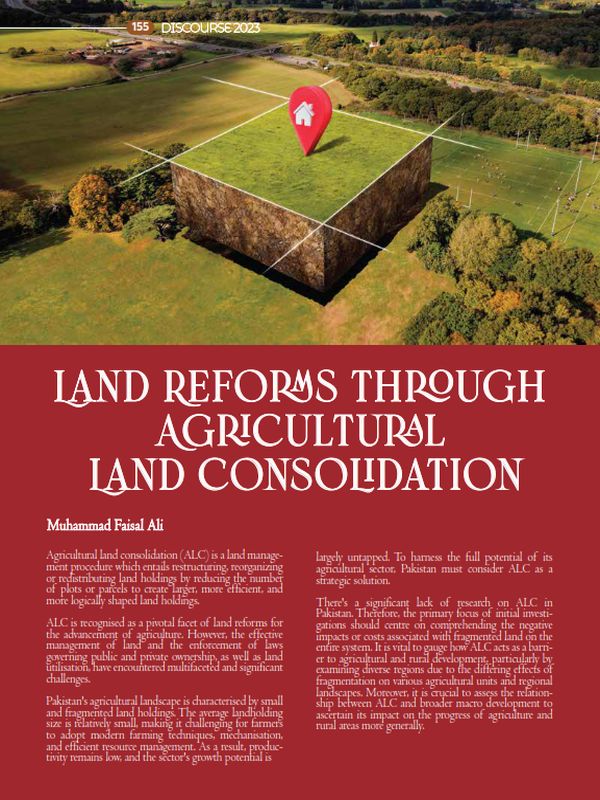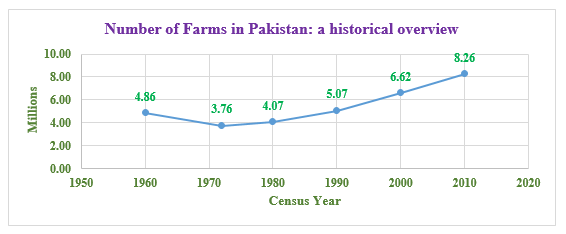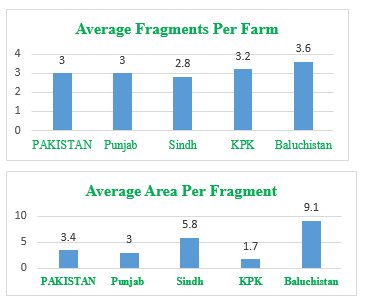
Pakistan Institute of Development Economics
- Home
Our Portals
MenuMenuMenuMenuMenuMenuMenu - ResearchMenuMenuMenuMenuMenuMenuMenu
- Discourse
- The PDR
- Our Researchers
- Academics
- Degree Verification
- Thesis Portal
- Our Portals
Land Reforms through Agricultural Land Consolidation
Agricultural land consolidation (ALC) is a land management procedure which entails restructuring, reorganizing or redistributing land holdings by reducing the number of plots or parcels to create larger, more efficient, and more logically shaped land holdings.
ALC is recognised as a pivotal facet of land reforms for the advancement of agriculture. However, the effective management of land and the enforcement of laws governing public and private ownership, as well as land utilisation, have encountered multifaceted and significant challenges.
Pakistan’s agricultural landscape is characterised by small and fragmented land holdings. The average landholding size is relatively small, making it challenging for farmers to adopt modern farming techniques, mechanisation, and efficient resource management. As a result, productivity remains low, and the sector’s growth potential is largely untapped. To harness the full potential of its agricultural sector, Pakistan must consider ALC as a strategic solution.
There’s a significant lack of research on ALC in Pakistan. Therefore, the primary focus of initial investigations should centre on comprehending the negative impacts or costs associated with fragmented land on the entire system. It is vital to gauge how ALC acts as a barrier to agricultural and rural development, particularly by examining diverse regions due to the differing effects of fragmentation on various agricultural units and regional landscapes. Moreover, it is crucial to assess the relationship between ALC and broader macro development to ascertain its impact on the progress of agriculture and rural areas more generally.
A starting point for this analysis is to comprehensively understand both present and past trends in distribution of agricultural land in Pakistan. Agricultural land distribution has undergone a rapid transformation. Over the last five decades, the number of farms has surged, rising from 3.76 million to 8.26 million. Notably, the pace of this increase accelerated significantly between 2000 and 2010, when the number of farms expanded from 6.62 million to 8.26 million, representing an astonishing 25 percent growth rate. This data is 13 years old, and there have been no agricultural censuses conducted since. Therefore, it is entirely plausible that, based on past trends, the current figure could be around 10 million.
This situation worsens in case of fragments. The average number of fragments per farm is three in Pakistan. Out of the total 8.26 million farms, 34 percent exhibit fragmentations, accounting for a total of 8.58 million fragments. Among the 8.56 million fragments, 6.55 million fragments are associated with farmers who own less than 12.5 acres of land. Analysing the distribution of fragments in more depth, it may be concluded that 2.1 million farms have an average of 2-3 fragments, 0.45 million farms have an average of 4-5 fragments, 0.24 million farms have an average of 6-9 fragments, while 9,053 farms possess more than 10 fragments in Pakistan.
The average number of fragments per farm is 3 in Pakistan. However, in different regions, there is not much variation in terms of the average number of fragments per farm: average fragments per farm are 3 in Punjab, 2.8 in Sindh, 3.2 in KPK, and 3.6 in Baluchistan.
On the other hand, when it comes to the average area per fragment, there are noticeable differences in different provinces. The average area per fragment is 3.4 acres in Pakistan as a whole. In specific regions, however, this varies: with average areas per fragment being 3 acres in Punjab, 5.8 acres in Sindh, 1.7 acres in KPK, and 9.1 acres in Baluchistan. Therefore, Baluchistan carries the largest area per fragment whereas KPK holds the least area per fragment in Pakistan.
Fragmented land can lead to inefficiencies in land use, making it difficult to implement cohesive and productive agricultural strategies. ALC helps in reducing the fragmentations by consolidating these parcels, allowing farmers to create larger and more uniform fields – making it easier to use modern farming equipment and practices effectively. ALC allows better land use planning at both the local and regional levels balancing agricultural needs with other developmental priorities. Therefore, ALC emerges as the most fitting solution in response to diminishing land sizes and increasing fragments. This approach has demonstrated its effectiveness in numerous regions worldwide, including countries such as China, Japan, India, and Turkey.
Smaller farms often encounter obstacles when attempting to adopt modern farming machinery due to their limited scale. Through consolidation, there will be increased access to mechanisation and financial resources. Larger, consolidated fields are better suited for the use of modern agricultural machinery, such as tractors, combine harvesters, and advanced irrigation systems – which can significantly increase efficiency and speed of various farming operations, from planting to harvesting.
ALC often leads to economies of scale, providing advantages of bulk purchasing of inputs, such as seeds, fertilisers, and pesticides, creating the conditions for farmers to benefit from lower per-unit production costs. This can result in increased profitability and productivity – in turn enabling small farmers to engage in value-added activities such as food processing, packaging, and marketing whilst also gaining access to larger markets through the establishment of efficient value chains. Ultimately, this enhances their profitability.
The legal framework provides an avenue for residents in a particular area to instigate ALC, contingent upon their ability to provide documented evidence that a majority, specifically 51 percent at least, of the village’s inhabitants support the initiative. Those in support can propose a consolidation scheme, which the revenue officer will publish as it falls under the jurisdiction of the Board of Revenue. If no objections are raised within a specified timeframe, the scheme can be implemented. In case objections do arise, individuals can file an appeal with the collector within 60 days. If the issue remains unresolved, a subsequent appeal can be made to the Commissioner within another 60-day period, with the Commissioner serving as the final authority in such matters. In situations where the applicant does not submit a consolidation scheme, the Revenue Officer is responsible for preparing one, following the same procedure. If the number of individuals willing to participate in land consolidation is less than 51 percent, consolidation can still proceed, but it will only apply to those who have requested it.
However, a profound awareness of the intricate web of land ownership and the associated social dynamics is essential when implementing ALC. Moreover, precise and up-to-date land documentation, local zoning regulations dictating permissible land uses, as well as land subdivision and consolidation rules, hold paramount significance. Challenges associated with land titles, boundary disputes, tenancy rights, and the maintenance of land records can pose obstacles. Further, land consolidation may encounter resistance from landowners who harbor concerns about potential encroachment on their land rights. But they can be resolved through careful strategising, efficient and transparent regulatory mechanisms, and active community involvement. Conclusively, a robust synergy among governmental entities (the executive, legislative, and regulatory bodies) alongside active engagement with farmers is a pre-requisite. Leveraging the research-based expertise of specialists stands as a crucial facet in tackling these challenges head-on within the realm of ALC.
Utilising mass media would be highly effective and impactful in promoting the achievements and benefits of ALC. Leveraging social media alongside radio and TV significantly amplifies the advantages of ALC, maximising its reach and influence. Additionally, organising visits to consolidated farms will further enhance the understanding and benefits of ALC, creating an additional layer of advantage and insight. Hence, the role of educational and promotional programs through agricultural activists and promoters can encourage the wider acceptance and adoption of ALC amongst farmers who haven’t consolidated their lands to embrace this process.
It is essential for relevant organisations, policymakers, and planners to acknowledge and integrate these initiatives into their strategies; the plans would be highly beneficial for promoting understanding and adoption of ALC among the farming community.
Recognising the effectiveness and significance of incentives can significantly bolster the acceptance of ALC amongst farmers. To achieve a broader impact, it is crucial to reassess incentive structures within the agriculture sector and they should be designed to complement ALC. Reviewing and adjusting funds, credits, and financial support mechanisms offered by various organisations and government entities will be a pivotal step in encouraging farmers for ALC.
The legal provisions coupled with promising advantages, create a strong case for embracing ALC in Pakistan. It would lay the foundation for a more prosperous and sustainable agricultural future. This transformation will not only bring benefits to farmers but also play a significant role in bolstering food security, fostering rural development, and contributing to overall economic growth.
References
All the Agricultural Censuses of Pakistan :1960, 1972, 1980, 1990, 2000 & 2010
The author is a Research Fellow at the Pakistan Institute of Development Economics (PIDE), Islamabad





